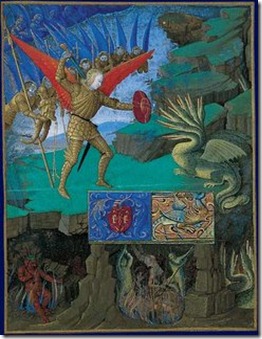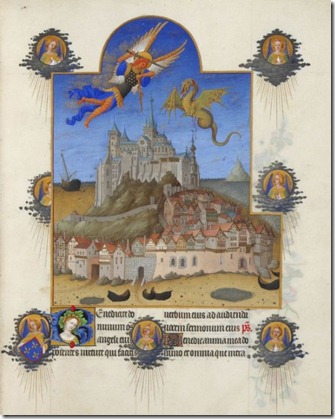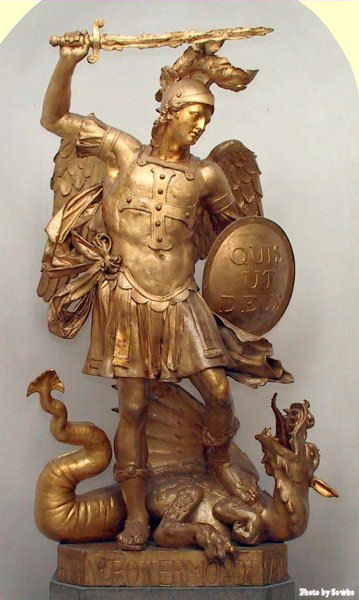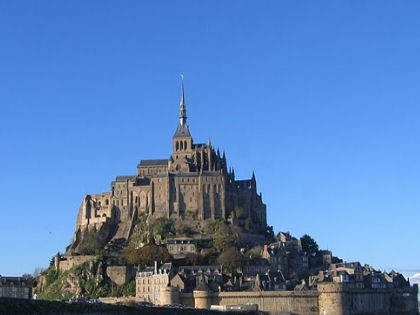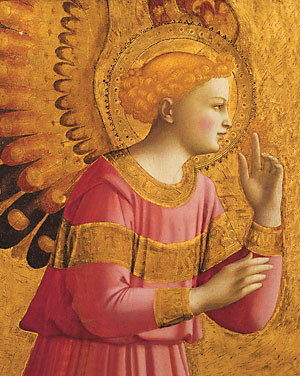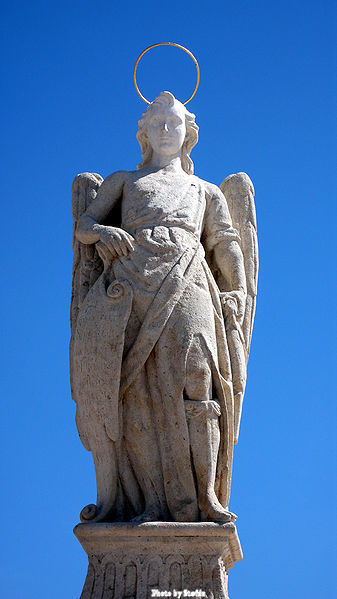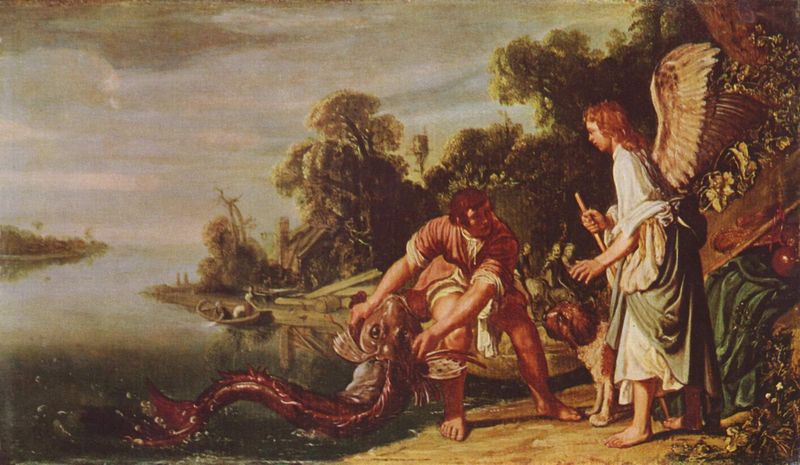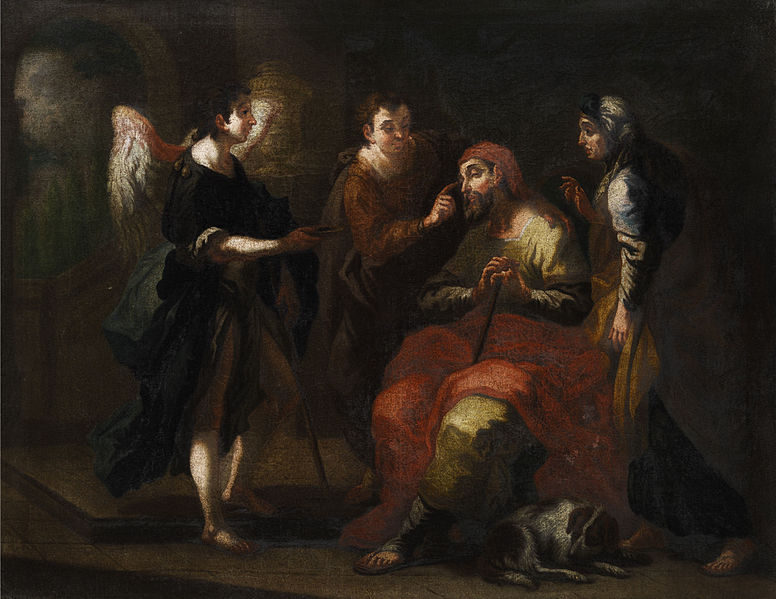Saint Michael the Archangel: “Who is like God?”
In Hebraic, mîkâ’êl, means “Who is like God?”
The Scriptures refer to the Archangel Saint Michael in four different passages: two of them, in Daniel’s prophesy (chap. 10, 13 and 21; and chap. 12, 1); one in Saint Jude Thaddeus (single chapter, vers. 9) and, finally, in the Revelation (chap. 12, 7-12).
In the Book of Daniel, the Saint Archangel appears as the “prince and protector of Israel”, who opposes the “prince”, or heavenly protector of the Persians.
According to Saint Jerome and other commentators, the Angel protector of Persia desired that some of the Jews would remain there to expand the knowledge of God; however, Saint Michael desired and asked the Lord that all Jews return to Palestine, to allow the Temple of the Lord to be completed in less time. The spiritual fight between the two Angels lasted twenty one days.
Saint Jude, in his Epistle, alludes to a dispute between Saint Michael and the demon over Moses’ body: the glorious Archangel – by God’s disposition – wanted Moses’ sepulcher to remain hidden; the demon, however, tried to make it known, with the objective of giving to the Jews an occasion to fall into idolatry, through the influence of the neighboring pagan peoples.
In Revelation, Saint John presents Saint Michael as commander-in-chief of the good Angels in a great fight in Heaven, against the rebel Angels, led by Satan, the dragon:
“Now war arose in heaven, Michael and his Angels fighting against the dragon; and the dragon and his Angels fought, but they were defeated and there was no longer any place for them in heaven. And the great dragon was thrown down, that ancient serpent, who is called the Devil and Satan, the deceiver of the whole world — he was thrown down to the earth, and his Angels were thrown down with him” (Revelation 12, 7-12).
The Church did not define anything in particular about Saint Michael, but has permitted that the beliefs originated from the Christian traditions about the glorious Archangel have free course in the piety of the faithful and in the writings of the theologians.
The first of these beliefs is that Saint Michael was, in the Old Testament, the defender of the chosen people, Israel – and nowadays, he is the defender of the new chosen people, the Church.
This pious belief is in accordance with what is said in Daniel: “… but Michael, one of the chief princes, came to help me… Michael, your prince” – that is, prince of the Jews (Dan 10, 13 e 21); and again “At that time shall arise Michael, the great prince who has charge of your people”, the people of Israel (Dan 12, 1).

Statue of St. Michael on St. Michaelskirche Church in Siegen, Germany. The left wing of the angel statue was damaged in 1944 by bomb splinters. The damage was as a reminder of the Second World War left intentionally so, and the rest of the church was restored.
This is a very ancient belief, being also confirmed by the Shepherd of Hermas, a celebrated Christian book of the II Century, in which one can read: “The great and honorable Michael is the one who has the power over this people” (the Christians).
Additionally, this is also believed by theologians and the Church, who corroborate it in several different ways.
The second of these beliefs is that Saint Michael has the power to admit, or not, the souls in Paradise.
In the Divine Office for this holy Archangel, in the old Breviary, Saint Michael was called “Praepositus paradisi”– “Guardian of the Paradise”, to whom God addresses Himself in the following terms: “Constitui te Principem super omnes animas suscipiendas” – “I constituted you the master above all souls to be admitted”. And, in the Mass for the Dead there was the prayer: “Signifer Sanctus Michael representet eas in lucem sanctam” – “O Flag-bearer Saint Michael, lead them to the holy light”.
The third of these beliefs, or rather, the third opinion is that Saint Michael occupies the first place in the angelic hierarchy.
About this opinion, there are divergences amongst the theologians, but, this opinion has the support of several Greek Fathers of the Church and seems to be corroborated by the Latin liturgy, which refers to the glorious Archangel as the “Princeps militiae coelestis quem honorificant coelorum cives” – “Prince of the celestial hosts, honored by all inhabitants of Heaven” and by the Greek liturgy, which calls him “Archistrátegos“, that is, “Mighty General”, or “Generalissimo”.
The great commentator of the Sacred Scriptures, Fr. Cornelius a Lapide, a Jesuit from the XVI Century, writes:
“Many consider that Michael, due to his dignity and nature, and to his grace and glory, is the absolute first and the Prince of all Angels. And this is proved, first, by the book of Revelation (12, 7), where it is said that Michael fought against Lucifer and his Angels, resisting his arrogance with a cry full of humility: ‘Who is like God?’ Therefore, in the same way as Lucifer is the chief of the demons, Michael is the chief of the Angels, being the first among the Seraphim. Second, because the Church calls him Prince of the Heavenly Hosts, who is placed at the gates of Paradise. And it is in his name that we celebrate the Feast of All Angels. Third, because Michael is today exalted as the protector of the Church, as in olden days he was exalted as the protector of the Synagogue. Finally, four, because it is probable that Saint Michael is the Prince of all Angels and the first amongst the Seraphim because Saint Basil says in his Homily De Angelis: ‘To you, O Michael, general of the celestial spirits, who by his honor and dignity is placed in front of all other heavenly spirits, to you I supplicate…’ ”.
The same thing is repeated by numerous other authors, Saint Robert Bellarmine included.
In the middle ages, Saint Michael was the special patron of the Orders of Chivalry which defended Christendom against the Muslim danger.
St. Gabriel the Archangel: “Strength of God”
“Fortitudo Dei”, one of the three archangels mentioned in the Bible. Only four appearances of Gabriel are recorded:
- In Dan., viii, he explains the vision of the horned ram as portending the destruction of the Persian Empire by the Macedonian Alexander the Great, after whose death the kingdom will be divided up among his generals, from one of whom will spring Antiochus Epiphanes.
- In chapter ix, after Daniel had prayed for Israel, we read that “the man Gabriel . . . . flying swiftly touched me” and he communicated to him the mysterious prophecy of the “seventy weeks” of years which should elapse before the coming of Christ. In chapter x, it is not clear whether the angel is Gabriel or not, but at any rate we may apply to him the marvelous description in verses 5 and 6.
- In the New Testament he foretells to Zachary the birth of the Precursor, and
- to Mary that of the Savior.
Thus he is throughout the angel of the Incarnation and of Consolation, and so in Christian tradition Gabriel is ever the angel of mercy while Michael is rather the angel of judgment. At the same time, even in the Bible, Gabriel is, in accordance with his name, the angel of the Power of God, and it is worthwhile noting the frequency with which such words as “great”, “might”, “power”, and “strength” occur in the passages referred to above. The Jews indeed seem to have dwelt particularly upon this feature in Gabriel’s character, and he is regarded by them as the angel of judgment, while Michael is called the angel of mercy. Thus they attribute to Gabriel the destruction of Sodom and of the host of Sennacherib, though they also regard him as the angel who buried Moses, and as the man deputed to mark the figure Tau on the foreheads of the elect (Ezech., 4). In later Jewish literature the names of angels were considered to have a peculiar efficacy, and the British Museum possesses some magic bowls inscribed with Hebrew, Aramaic, and Syriac incantations in which the names of Michael, Raphael, and Gabriel occur. These bowls were found at Hillah, the site of Babylon, and constitute an interesting relic of the Jewish captivity. In apocryphal Christian literature the same names occur, cf. Enoch, ix, and the Apocalypse of the Blessed Virgin.

St. Gabriel, statue at the corner of The Doge’s Palace in Venice, next to Porta della Carta. Photo by G.dallorto
As remarked above, Gabriel is mentioned only twice in the New Testament, but it is not unreasonable to suppose with Christian tradition that it is he who appeared to St. Joseph and to the shepherds, and also that it was he who “strengthened” Our Lord in the garden (cf. the Hymn for Lauds on 24 March). Gabriel is generally termed only an archangel, but the expression used by St. Raphael, “I am the angel Raphael, one of the seven, who stand before the Lord” (Tob., xii, 15) and St. Gabriel’s own words, “I am Gabriel, who stand before God” (Luke 1, 19), have led some to think that these angels must belong to the highest rank; but this is generally explained as referring to their rank as the highest of God’s messengers, and not as placing them among the Seraphim and Cherubim (cf. St. Thomas, I, Q. cxii, a.3; III, Q. xxx, a.2, ad 4um).
St. Raphael the Archangel: “Healer of God”
The name of this archangel does not appear in the Hebrew Scriptures, and in the Septuagint only in the Book of Tobias. Here he first appears disguised in human form as the traveling companion of the younger Tobias, calling himself “Azarias the son of the great Ananias”. The story of the adventurous journey during which the protective influence of the angel is shown in many ways including the binding “in the desert of upper Egypt” of the demon who had previously slain seven husbands of Sara, daughter of Raguel, is picturesquely related in Tobias 5-11, to which the reader is referred. After the return and the healing of the blindness of the elder Tobias, Azarias makes himself known as “the angel Raphael, one of the seven, who stand before the Lord” (Tob., xii, 15. Cf. Apoc., viii, 2). Of these seven “archangels” which appear in the angelology of post-Exilic Judaism, only three, Gabriel, Michael and Raphael, are mentioned in the canonical Scriptures. The others, according to the Book of Enoch (cf. xxi) are Uriel, Raguel, Sariel, and Jerahmeel, while from other apocryphal sources we get the variant names Izidkiel, Hanael, and Kepharel instead of the last three in the other list.
Regarding the functions attributed to Raphael we have little more than his declaration to Tobias (Tobias 12) that when the latter was occupied in his works of mercy and charity, he (Raphael) offered his prayer to the Lord, that he was sent by the Lord to heal him of his blindness and to deliver Sara, his son’s wife, from the devil. The Jewish category of the archangels is recognized in the New Testament (I Thess., iv, 15; Jude, 9), but only Gabriel and Michael are mentioned by name. Many commentators, however, identify Raphael with the “angel of the Lord” mentioned in John 5. This conjecture is base both on the significance of the name and on the healing role attributed to Raphael in the Book of Tobias.
The Church assigns the feast of St. Raphael to 24 October. The hymns of the Office recall the healing power of the archangel and his victory over the demon. The lessons of the first Nocturn and the Antiphons of the entire Office are taken from the Book of Tobias, and the lessons of the second and third Nocturns from the works of St. Augustine, viz. for the second Nocturn a sermon on Tobias (sermon I on the fifteenth Sunday), and for the third, a homily on the opening verse of John, v. The Epistle of the Mass is taken from the twelfth chapter of Tobias, and the Gospel from John 5:1-4, referring to the pool called Probatica, where the multitude of the infirm lay awaiting the moving of the water, for “an angel of the Lord descended at certain times into the pond; and the water was moved. And he that went down first into the pond after the motion of the water was made whole of whatsoever infirmity he lay under”. Thus the conjecture of the commentators referred to above is confirmed by the official Liturgy of the Church.
(cf. 1913 Catholic Encyclopedia – English adapted by Nobility.org)
